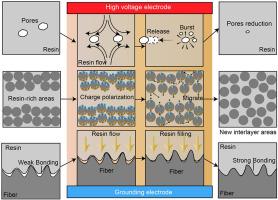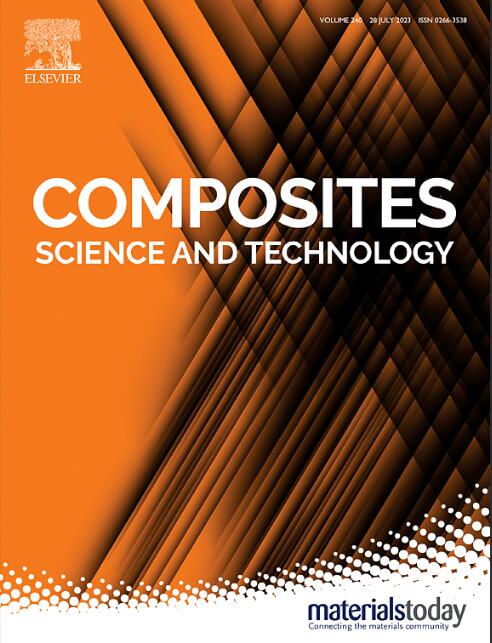固化过程中双极 nsPDC 电场在 CFRP 层压板内产生的电流体动力效应
IF 8.3
1区 材料科学
Q1 MATERIALS SCIENCE, COMPOSITES
引用次数: 0
摘要
本文开发了一种基于双极纳秒脉冲叠加直流(nsPDC)电场辅助固化技术的新方法,用于制造改性纤维增强复合材料,以提高其机械性能。研究发现,电场改性 CFRP 层压板的模式 I 层间断裂韧性达到 1014.2 MPa,提高了 80.4%。平均拉伸强度和拉伸模量分别为 2180 兆帕和 100780 兆帕,比空白对照组分别提高了 20.7% 和 3.5%。通过 COMSOL 仿真、固化温度检测和电子显微镜的微观表征,对增强机制进行了探索。结果表明,层压板内部电场和电场力的存在会影响树脂的流动和纤维的微弱迁移,从而在不显著改变固化温度的情况下消除材料中存在的较大气泡,减少层间树脂富集区,并改善纤维与树脂的润湿性。所提出的简单、方便、环保的策略可以有效解决传统制造方法中的一些不足,因此适用于纤维增强复合材料的优化设计。本文章由计算机程序翻译,如有差异,请以英文原文为准。

Electrohydrodynamic effect within CFRP laminates by bipolar nsPDC electric field during the curing process
In this paper, a new method based on bipolar nanosecond pulsed superimposed direct current (nsPDC) electric field assisted curing technique was developed to fabricate modified fiber-reinforced composites to enhance their mechanical properties. It was found that the mode I interlaminar fracture toughness of the electric field-modified CFRP laminates reached 1014.2 MPa, which increased by 80.4 %. The average tensile strength and tensile modulus were 2180 MPa and 100780 MPa, respectively, which were 20.7 % and 3.5 % higher than the blank control group. The enhancement mechanism was explored by COMSOL simulation, curing temperature inspection, and microscopic characterization by electron microscopy. The results show that the presence of electric field and electric field force inside the laminate, which affects the flow of resin and the weak migration of fibers, enables the elimination of larger air bubbles present in the material, the reduction of resin-rich zones in the interlayer as well as the improvement of the fiber-resin wettability without significantly altering the curing temperature. The proposed simple, convenient, and environmentally friendly strategy can effectively regulate some of the deficiencies in the conventional manufacturing methods and thus is suitable for the optimal design of fiber-reinforced composites.
求助全文
通过发布文献求助,成功后即可免费获取论文全文。
去求助
来源期刊

Composites Science and Technology
工程技术-材料科学:复合
CiteScore
16.20
自引率
9.90%
发文量
611
审稿时长
33 days
期刊介绍:
Composites Science and Technology publishes refereed original articles on the fundamental and applied science of engineering composites. The focus of this journal is on polymeric matrix composites with reinforcements/fillers ranging from nano- to macro-scale. CSTE encourages manuscripts reporting unique, innovative contributions to the physics, chemistry, materials science and applied mechanics aspects of advanced composites.
Besides traditional fiber reinforced composites, novel composites with significant potential for engineering applications are encouraged.
 求助内容:
求助内容: 应助结果提醒方式:
应助结果提醒方式:


